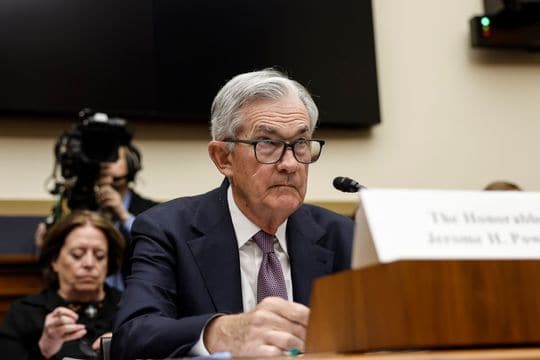U.S. stock indexes ended mixed on Wednesday, attempting to recover from Tuesday’s broad-based selloff following comments by Federal Reserve chairman Jerome Powell suggesting more interest rate rises may be necessary to tame inflation than investors were expecting.
How stock indexes traded
- S&P 500 SPX, +0.14% gained 5.64 points, or 0.1%, to end at 3,992.01 points
- Dow Jones Industrial Average DJIA, -0.18% fell 58.06 points, or 0.2%, to finish at 32,798.40
- The Nasdaq Composite COMP, +0.40% rose 45.67 points, or 0.4%, ending at 11,576
On Tuesday, the Dow Jones Industrial Average fell 575 points, or 1.72%, to 32,856, the S&P 500 declined 62 points, or 1.53%, to 3,986, and the Nasdaq Composite dropped 145 points, or 1.25%, to 11,530.
What drove markets
Investors tuned in to the second day of Fed Chair Powell’s semiannual monetary policy testimony to Congress in which Powell said the central bank has not made any decision on the size of a potential interest rate hike later this month despite strong labor market data and a rise in inflation in January.
Powell, in a testimony to the House Financial Services panel, said the central bank has yet to decide how large an interest rate hike to impose at its next meeting in two weeks.
“We have not made any decision about the March meeting. We’re not going to do that until we see the additional data,” Powell said, while emphasizing that the Fed is not on a “pre-set path.”
“We will be guided by the incoming data and the evolving outlook,” he said.
On Tuesday, Powell told the Senate Banking Committee that the central bank was prepared to increase the pace of interest rate hikes if data indicated it was warranted to damp inflation.
“The market has interpreted what he[Powell] said as being an indication that we may see higher rate hikes at the next meeting than we previously have expected, and that the terminal rate will be higher than what markets had priced in a month or so ago,” Richard Flax, chief investment officer at Moneyfarm, said before Powell’s testimony Wednesday.
“You’ve seen the narrowing of the gap between market expectations and perhaps the Fed dot plot at the last release,” said Flax in a call.
Powell’s comments on Tuesday hammered government bonds, driving short-term 2-year yields TMUBMUSD02Y, 5.045% to the highest level since 2007, as the market increased bets that the Fed may hike rates by 50 basis points in two week’s time, and ultimately take rates as high as 5.65% by the end of this year, according to CME FedWatch tool.
In data published Wednesday, job openings in the U.S. fell in January to 10.8 million from 11.2 million in December, the Labor Department said. However, the still-high number of available jobs suggested the labor market remained extremely strong.
“The labor market remains extremely tight despite 450 basis points of rate hikes in the last year,” said Ronald Temple, chief market strategist at Lazard.
“Friday’s employment report will give us more insight into the degree of tightness in the labor market, but this report [jobs openings report] adds weight to the Chair Powell’s comments yesterday suggesting a 50-basis point rate hike on March 22 could be in the cards.”
Meanwhile, U.S. private payrolls rose by 242,000 in February, according to the payroll services firm ADP on Wednesday. That’s up from a revised 119,000 in prior month. Economists polled by The Wall Street Journal had forecast a gain of 205,000 private sector jobs.
The Fed’s Beige Book survey showed U.S. overall economic activity increased slightly in early 2023, while inflationary pressures still remained widespread, though price increases moderated in many Federal Reserve Districts.
The report was based on anecdotal information collected by the Fed’s 12 regional banks and is published eight times each year before the policy-setting Federal Open Market Committee meetings.
In other economic data, the U.S. trade deficit widened by 1.6% to $68.3 billion in January. U.S. imports rose 3% to $325.8 billion in January, while exports were up 3.4% to $257.5 billion.
Companies in focus
- Campbell Soup Co. CPB, +1.94% stock ended up 2% Wednesday after it beat Wall Street’s adjusted earnings estimate on a boost from higher prices for its food products.
- Occidental Petroleum Corp.’s stock OXY, +2.14% rose 2.1% after filings disclosed that Warren Buffett’s Berkshire Hathaway Inc. had upped its stake in the energy company by 6 million shares, taking its total to over 200 million shares worth more than $12 billion. Berkshire’s BRK.B, +0.08% stock ended nearly flat.
- CrowdStrike Holdings Inc. shares CRWD, +3.19% increased 3.2% after the security software company posted higher-than-expected fourth-quarter adjusted earnings and a fiscal first quarter outlook that also beat analyst expectations. D.A. Davidson also raised the stock’s price target to $165 from $145.
- Tesla Inc.’s stock TSLA, -3.04% stock moved down 3.1%, adding to the 3.2% drop in the previous session, which was part of a broader stock market selloff. Berenberg downgraded the electric vehicle maker from buy to hold, but raised the stock price target to $210 from $200, according to press reports.
- United Natural Foods Inc. UNFI, -28.05% plunged 28.1% toward a 19-month low in premarket trading Wednesday after the grocery wholesaler reported fiscal second-quarter profit that missed by a wide margin, as “rapidly accelerating inflation” took a bite out of results.

